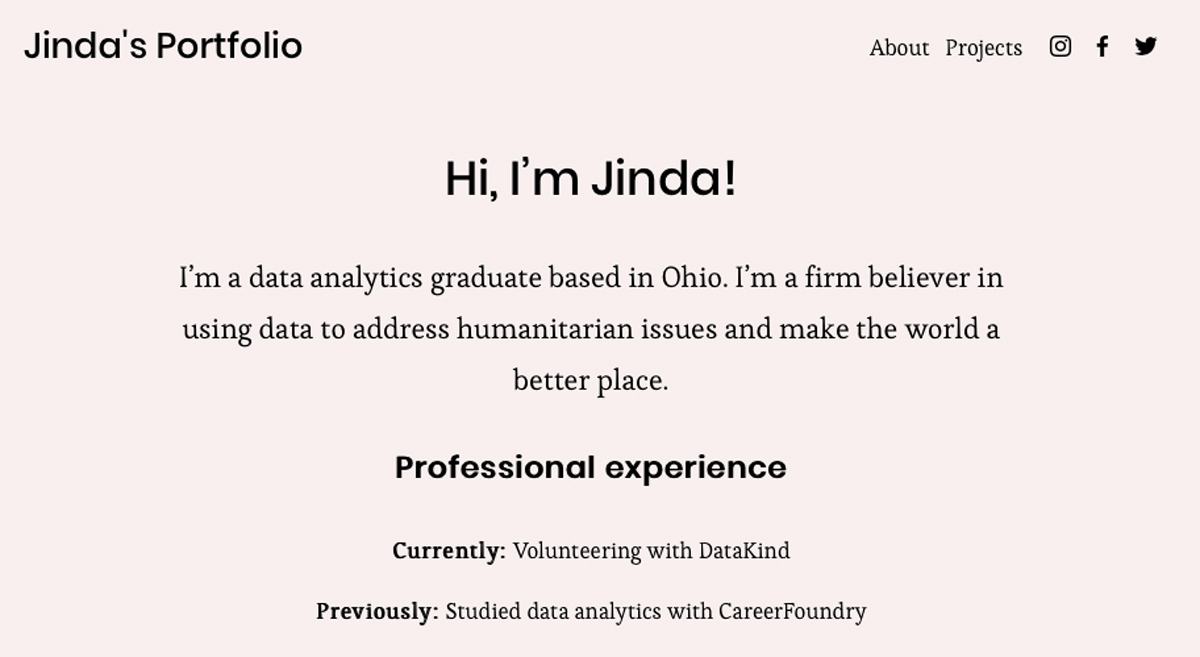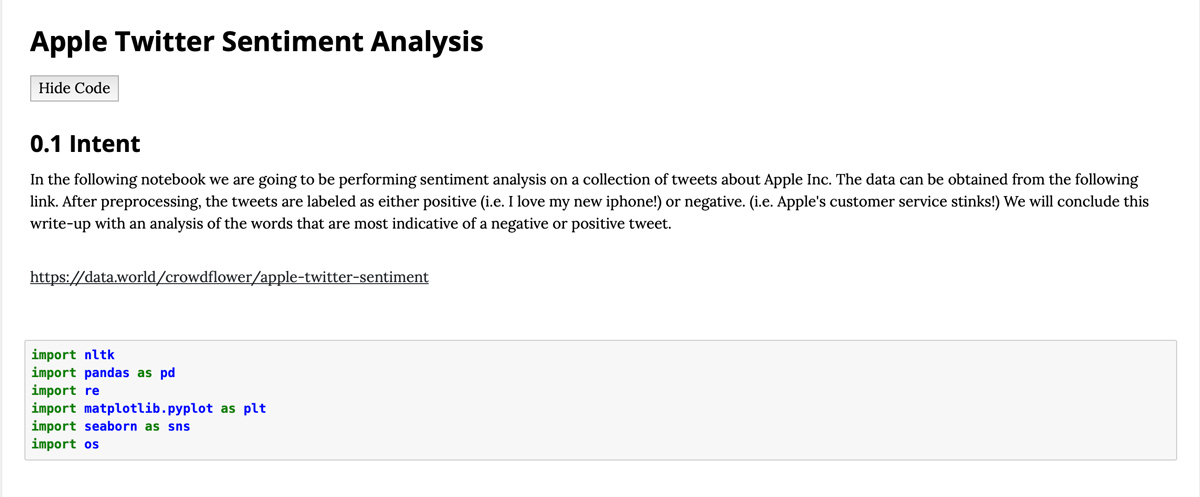Just as web developers show their code and designers share visual representations of their process, data analysts also need to demonstrate how they work with data to tackle complex problems. And, just like developers and designers, you can do this with your very own data analyst portfolio.
But what exactly is a data analyst portfolio? How do you put what you do into images and words? And, if you’re just starting out, how on earth do you find projects to include in your portfolio? The idea of a data analyst portfolio might seem strange and rather abstract, but fear not.
Interested in seeing if a data analytics could be for you? Try this free data short course on for size.
In this guide, we’ll show you how to build your data portfolio from scratch. We’ll cover:
- What is a data analyst portfolio and why is it important?
- What should you include in your data analyst portfolio?
- What skills should your data analyst portfolio demonstrate?
- How can you get portfolio projects without any experience?
- Building a data analyst portfolio: best practice
- How to present your data analyst portfolio during an interview
- Where can you go for data analyst portfolio examples and inspiration?
- Key takeaways and next steps
By the end of this post, you’ll be ready to showcase your skills—bringing you one step closer to your dream job as a data analyst.
1. What is a data analyst portfolio and why is it important?
In a hands-on field like data analytics, it’s not enough to simply tell employers what you can do; they want to see proof. While your resumé summarizes your qualifications and experience, a portfolio showcases your skills in action—making it an essential tool when applying for jobs.
In simple terms, a data analyst portfolio is a website which tells employers a little bit about you and links out to projects you’ve worked on. So, the very first step in building your portfolio is deciding where to host it. Depending on how involved you want to be in creating and customizing your portfolio website, you may wish to build something from scratch or to simply use a pre-built template. If you’re leaning towards the latter, check out sites like Squarespace, WordPress, and Wix (to name just a few).
2. What should you include in your data analyst portfolio?
Your portfolio website should be concise, easy to navigate, and visually appealing. There are three key areas you’ll want to include in your portfolio website, as well as an optional fourth. Let’s take a look at those now.
Your portfolio homepage
This is where potential employers first land when they visit your portfolio website, so it’s important to make a good first impression. Aim to keep things brief yet informative; the viewer should see, at a glance, who you are and what you do. On the homepage, we recommend including a photo of yourself, a high-impact opening statement, followed by a few lines summarizing your professional experience.
For example, your opening statement might read something like this: “Hi, I’m Jinda! I’m a data analytics graduate based in Ohio. I’m a firm believer in using data to address humanitarian issues and make the world a better place.”

Above is a very basic example of what your portfolio homepage might look like, created using Squarespace. However, this really is just the bare bones; we recommend including an image and choosing a design that reflects your personal brand.
An “About Me” section
From the homepage, potential employers (and any other curious browsers) should be able to navigate to your “About Me” page. This is where you can go into more detail about who you are, what you do, and what you’re passionate about. For an example of how to structure your “About” section, check out Naledi Hollbruegge’s portfolio website.
Naledi starts by introducing herself as a consulting data analyst and social researcher. She then goes on to explain, in just a few sentences, how her passion for data analytics grew, and what she can offer to potential clients. Finally, she recaps her professional history and leaves the reader with what she is open to.
Whether to use this or a call-to-action depends on your own position: Are you looking for recruiters or clients wanting to take you onboard to reach out to you? Tell them!
Beneath your “About Me” summary, be sure to include your contact details and links to any other online profiles (such as X/Twitter, LinkedIn, and GitHub).
Projects
Your data analyst portfolio should include a dedicated “Projects” section which showcases various projects you’ve worked on.
There are different ways of presenting your work; you may choose to host your portfolio projects right there on your website, or you might include a summary of your work which links out to the actual project which is hosted elsewhere (on GitHub, for example).
It all depends on the nature and technicalities of the project, as well as personal preference—many data analysts use a mixture of both approaches in their portfolios.
Harrison Jansma is a coder and data analyst by profession, and his portfolio provides a really good example of how to clearly and concisely showcase your work. In his Apple Sentiment Analysis project, Harrison demonstrates how he performed sentiment analysis (a technique used to classify opinions as positive, negative, or neutral) on a collection of tweets about Apple Inc. He lays out each step in clear, numbered sections, illustrating with tables and graphs where necessary.
While the whole project can be viewed within his portfolio website, Harrison also links out to the project code on an external site.

For another one, check out some of David Venturi’s personal projects. What I like is that he has a variety of different topics to browse, and isn’t afraid to do some data analysis on his passions, as evidenced by his work on hockey team the Toronto Maple Leafs. He typically uses GitHub to show off projects, such as this one made from OpenStreetMap data to learn more about his own hometown using SQL.
As you can see, there are different options as to where and how you showcase your work. Whichever approach you choose, it’s essential to include a meaningful and insightful summary of the project right there on your portfolio website.
You want to pique the reader’s interest and compel them to keep reading—whether that’s scrolling down to the end of the project or navigating to GitHub or another website. We’ll take a closer look at what your portfolio projects should demonstrate in section three.
A blog (optional)
When browsing data analyst and data scientist portfolios, you’ll notice that many of them include a blog. This might seem at odds with the world of data, but blogging actually serves as a very useful tool when it comes to demonstrating your skills as a data analyst. One key skill that employers will be looking for when hiring a data analyst is the ability to explain complex insights in a clear, concise, and easily comprehensible fashion—and this is something you can demonstrate in a blog post.
When you’re just starting out, consider writing one or two short articles explaining a certain concept. Not only does this show that you’re able to communicate and explain your work in a user-friendly way; it also shows that you’re passionate about what you do and have put plenty of thought and effort into your portfolio.
3. What skills should your data analyst portfolio demonstrate?
The main aim of a data analyst’s portfolio is to showcase your skills. Ideally, you’ll include a mixture of projects (and, optionally, blog posts) that highlight different aspects of your skillset. When building your portfolio and deciding what kinds of projects to include, focus on demonstrating the following:
- The ability to aggregate (or “scrape”) interesting data from a variety of sources.
- The ability to clean datasets thoroughly.
- The ability to run different types of analysis (e.g. descriptive or diagnostic), and the ability to apply different analysis techniques (e.g. time series analysis, A/B testing, regression analysis, etc.)
- The ability to visualize your findings—include graphs, charts, geomaps, and any other relevant visualizations.
- Knowledge of SQL.
- The ability to explain complex findings in a user-friendly way (for example, through your project write-up or in a blog post).
- The ability to work as part of a team—consider including a group project.
- A passion for what you do—address challenges that speak directly to your personal interests.
- Any skills you’ve mastered that will help you to stand out as a data analyst, such as knowledge of Python.
That may seem like a rather long list, and you might be wondering if you’ll ever have enough portfolio projects to demonstrate all of those fundamental skills. Well, fear not; there is an abundance of data everywhere just waiting to be analyzed. In the next section, we’ll consider how you can gather enough quality material for your data analyst portfolio, even if you don’t have any professional experience.
4. How can you get portfolio projects without any experience?
It’s that age-old conundrum that graduates, school-leavers, and career-changers face: You can’t get a job without experience, but you can’t get experience without a job. So how do you break the cycle?
If you don’t have any real-world experience as a data analyst, you can create your own by working on hypothetical projects. Think about a topic that interests you and go from there; this will ensure that the project is actually enjoyable and allow you to talk and write about it with genuine enthusiasm—something that employers will be looking out for.
Jason Goodman, a data scientist at airbnb, also recommends scraping your own data from the web rather than using pre-cleaned, ready-made datasets. As he explains: “Data cleaning, prep and transformation is a real part of any data job. Plus, it’s hard to get noticed if you’re using data everyone else has.” You’ll find a list of ten great websites offering free, open datasets here.
Another great option for getting started with your first portfolio project is to take a mini course. The CareerFoundry data analytics short course not only provides you with a thorough introduction to data analytics—it also comes with a dataset you can play around with (and it’s free).
Once you’ve identified your topic area, gathered your data, cleaned the dataset, and performed your analysis, you’ll focus on presenting your work in the form of a portfolio case study. Use both text and visuals to demonstrate what you set out to do, how you did it, and why it’s particularly interesting or useful. Where necessary, put the code you used on GitHub and link out to it so potential employers can view that, too.
Learn more: Is it possible to get a job as a data analyst without any prior experience?
What are some interesting project ideas for data analysts?
We mentioned the importance of coming up with project ideas and datasets that actually interest you, but admittedly, it can be difficult to get the ball rolling. If you’re stuck for ideas, start with a broader topic area and then funnel down to the specific questions you could ask (and answer) through data analytics. Here are some general topic ideas to help you get started:
- Social and humanitarian issues
- Healthcare
- Politics
- Movies, music, and celebrities
- Technology
- Local businesses
- Travel and transport
For more inspiration, check out this list of nine data analytics project ideas. It’s also worth browsing other people’s portfolios and seeing what kinds of projects they’ve included. We’ve highlighted some interesting data projects and portfolios in the next section.
5. Data analyst portfolios: best practice
You might have done some research into other data analyst portfolios and found that they’re a dime a dozen. Don’t let that discourage you, though—on the contrary, seeing a plethora of portfolios out there should give you some inspiration to make sure that yours really stands out!
When we talk about standing out, we don’t just mean design-wise. When it comes to recruiting for data analyst roles, recruiters are going to move fast, meaning that they may not have the time to sift through pages and pages of content that isn’t relevant to their search.
We’ve made up a list of best practices that you should aim to follow while building your portfolio, so that it addresses both your needs, as well as the needs of the potential recruiter clicking on your link!
- Demonstrate your passions through your projects: interested in healthcare? Make a point to list your health-related analyses and visualizations first. Got a passion for fashion and e-commerce? Show your recommendations on online shopping through mock projects.
- Show relevant use of tools such as R or Jupyter Notebook: make use of these web applications that allow you to share live code, text, and visualizations in an interactive way. That will give recruiters and managers a more hands-on look at your work.
- Curate the selection—only include the best in your data analyst portfolio! You may love all your children (projects) equally, but that doesn’t mean everyone else will. Recruiters are working with borrowed time. If they feel like going through your data analyst portfolio is a slog, they’re more likely to click off and move on to the next. Ask your peers and mentors to help you sift through your projects if you find it hard to decide.
- Get your portfolio up early, and adapt as you learn: are you making your way through a data analytics course and finished your first capstone project? Now’s a great time to build your portfolio and add that as the first project. As you continue to learn, you can add (and remove) projects as necessary. Starting early will make updating your data analyst portfolio a habit, so it doesn’t feel too daunting when it comes time to look for a job.
- Peek at your peers’ data analyst portfolios for inspiration: you’re all in this together! Ask your fellow students or contacts for their portfolio links, and send them yours! In addition to getting inspiration directly from their page, your peers may provide valuable feedback to apply later on down the track.
6. How to present your data analyst portfolio during an interview
When you start your data analyst job search, you should make a point to include a link to your portfolio where it makes sense: on your LinkedIn profile, and as a hyperlink on your data analyst resume. However, don’t assume that the recruiter has seen this link, even if you get called for an interview.
Discussions about your previous experience will naturally come up in the data analyst interview questions. If you’re meeting in person, bringing a tablet that you can display your portfolio easily on (or printouts!) will suffice. If you’re being interviewed online, ask to share your screen directly to your portfolio page. Don’t forget to make use of the STAR method when talking about your projects!
7. Where can you go for data analyst portfolio examples and inspiration?
If you’ve browsed the web for data analyst portfolio inspiration, you’ll have noticed that data analyst portfolios are actually rather hard to come by. This is due, in part, to the fact that the increasing demand for data analysts is a relatively new trend—we can certainly expect to see more and more data analyst portfolios emerging in the near future. At the same time, the data analyst job title is often used interchangeably with that of the data scientist, and so a search for data analyst portfolios inevitably brings up a majority of data scientist portfolios.
When creating your own portfolio, it’s important to be mindful of the differences between a data analyst and a data scientist, and to make sure that you’re highlighting the relevant skills accordingly.
With that in mind, here are some data analyst portfolios and projects that you can take inspiration from when building your own portfolio:
- Harrison Jansma, coder and analyst.
- Naledi Hollbruegge, analytics consultant and social researcher.
- Alina Bolat, aspiring data analyst.
- Senior data analyst Kim Tricker’s data visualization projects on Tableau Public.
- Philip Okoampah Kwaning’s data visualization projects on Tableau Public.
- OkCupid’s analysis of changes in online dating behaviors during the COVID-19 pandemic.
- David Robinson’s text analysis of Donald Trump’s tweeting activity.
We’ve included just a handful of examples here, but hopefully they’ll provide some valuable insight into how to construct your data analyst portfolio—and spark some interesting project ideas!
8. Key takeaways and next steps
A data analyst portfolio is an essential tool when it comes to starting—and advancing—your career as a data analyst. Your portfolio should demonstrate your ability to gather and clean data, to run different types of analysis, to visualize your findings, and to communicate what these findings mean and why they’re important. At the same time, your portfolio should capture who you are and where your passion for data comes from; aside from the hard skills, employers also want to see genuine enthusiasm and curiosity.
In this article, we’ve outlined what you should include in your data analyst portfolio and offered some ideas as to how you might go about creating interesting portfolio projects. It’s also worth bearing in mind that a reputable data analytics course will help you to build your portfolio from scratch and give you interesting projects to work on, so you don’t necessarily need to go it alone.
You could also take some advice from Tom, our very own data expert here at CareerFoundry, to see what works best for your data analytics portfolio.
If you are considering a data analytics course, check out this list of the best data analytics bootcamps on the market right now. For more tips and advice on forging a career as a data analyst, check out the following:
